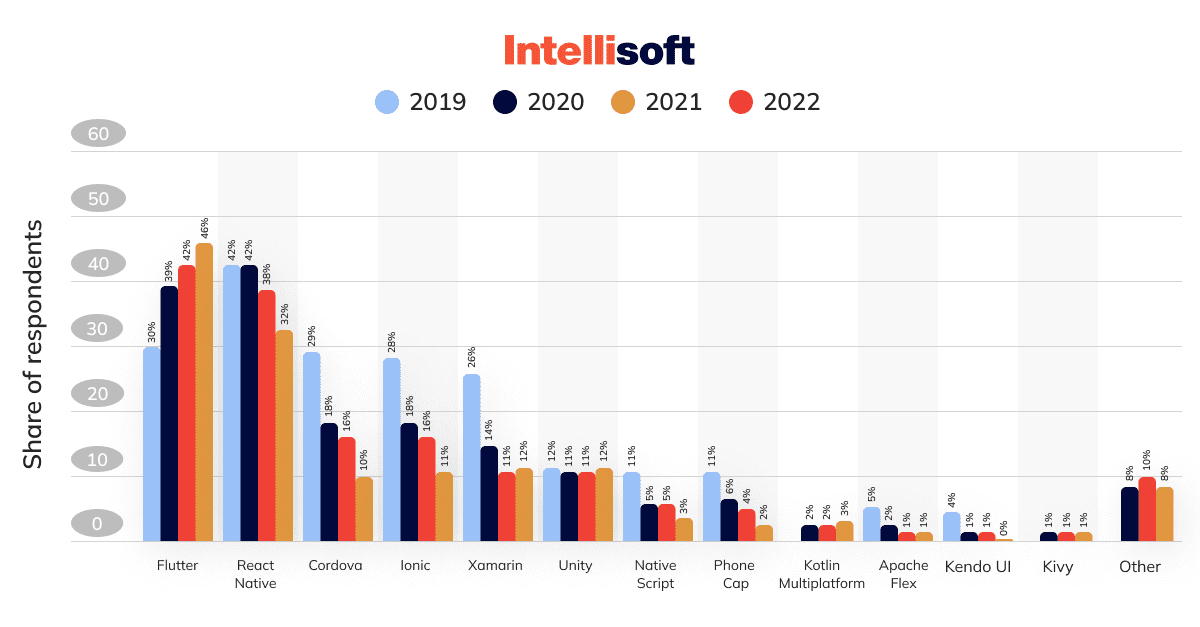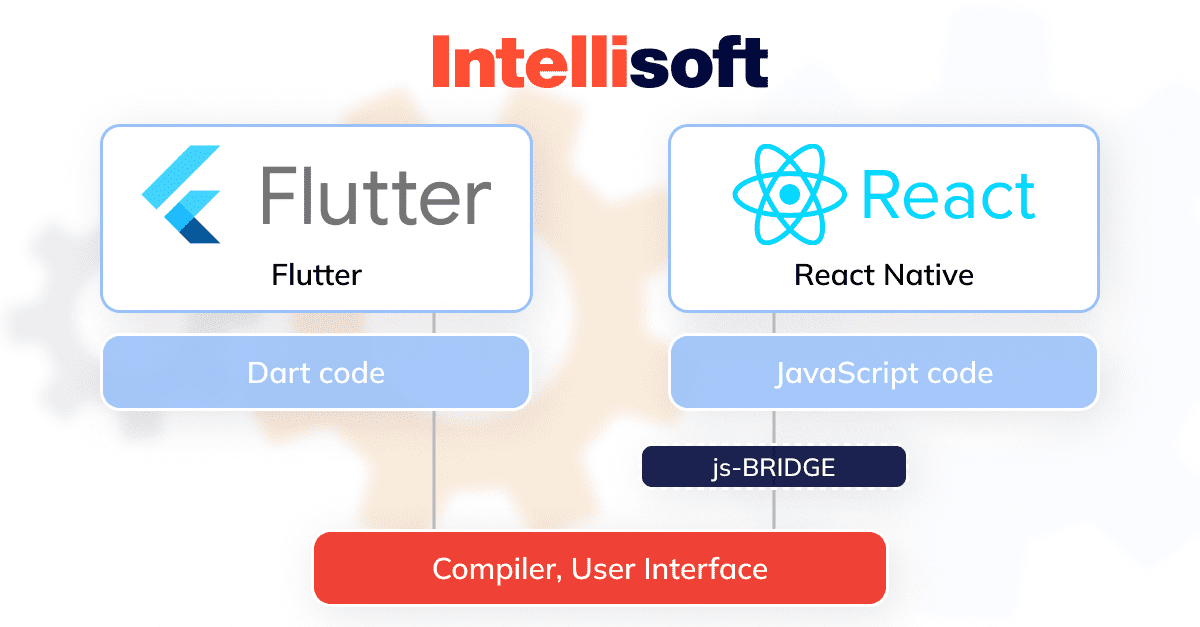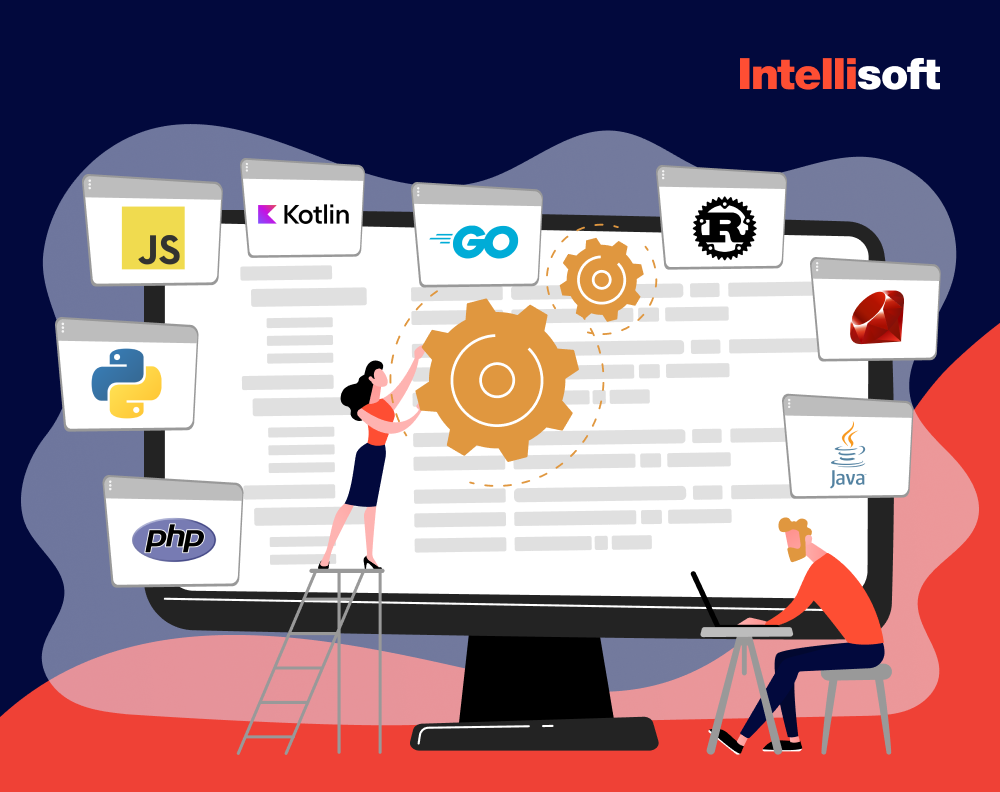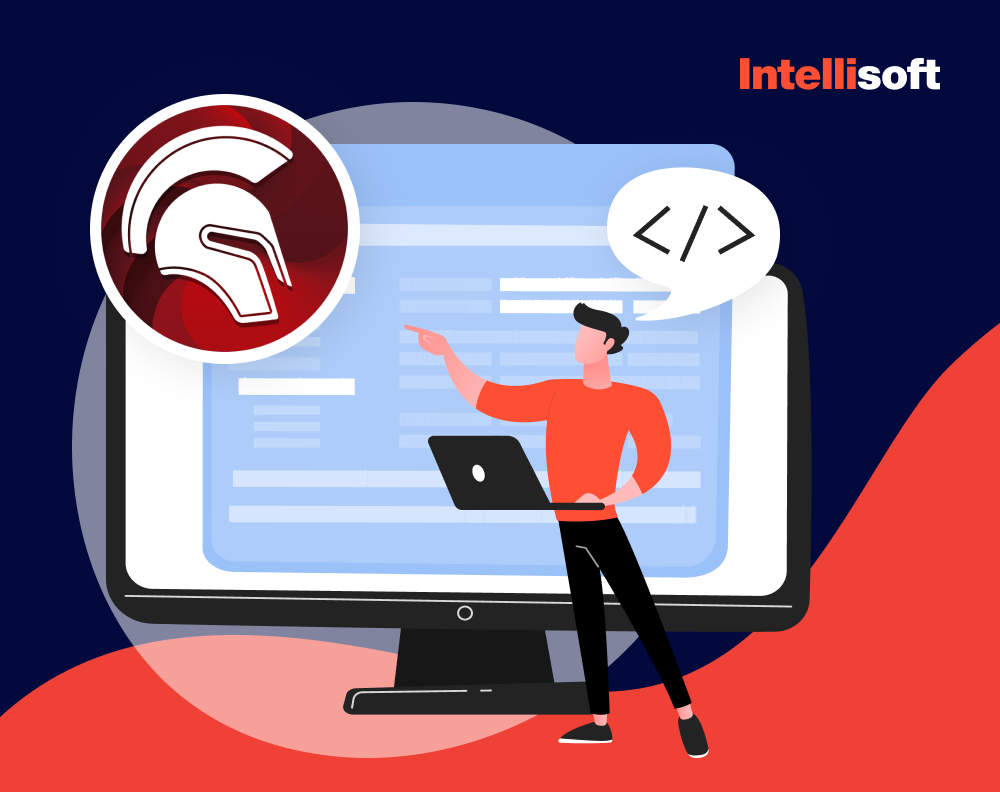The mobile phone has taken over the world. People use their smartphones for everything from checking the weather and texting friends to purchasing groceries and even working full-time. With so many aspects of our lives depending on these pocket-size devices, it’s no wonder that businesses these days want to develop apps faster and cheaper. Moreover, they’re eager to conquer App Store and Google Play at the same time without wasting money on developing native apps for both marketplaces.
At first, finding the technology that allowed all of this was more challenging than finding a unicorn. The two main players that have arisen on the horizon of cross-platform development are React Native and Flutter. These technologies are now used to develop apps both for iOS and Android, allowing developers to save time, money, and effort.
At IntelliSoft, we have over 10 years of experience developing cross-platform apps. Our developers have worked with Flutter and React Native, discovering their advantages and disadvantages, strengths and weaknesses. We are committed to helping you develop your cross-platform app and make the best choice between the two technologies, ensuring that your resources, money, and time are well-spent.
In this article, we will dive deep into the world of cross-platform development and talk about its whats, whys, and hows. We’ll cover Google Flutter vs React Native pros and cons, compare Flutter vs. React Native, and help you decide which one is right for you. If you’ve been at the crossroads all this time, fear not, we’ll guide you through and help you find your way.
Table of Contents
How Do Cross-Platform Development Frameworks Work?
All operating systems and platforms have their unique characteristics and requirements that should be taken into account when developing apps for them. You can’t just develop an app that will run seamlessly on multiple platforms. Or can you?
This is what cross-platform development frameworks are for; they allow developers to save time and resources and develop applications that work flawlessly on any OS or platform. They also enable developers to write code once and use it across different platforms: Windows, Android, and iOS.
These platforms also use certain libraries and tools that help get rid of the differences between platforms, helping developers write code that is universal and does not require modifications.
Cross-platform development frameworks allow developers to provide a consistent feel and look of the app across many platforms and devices, and update the apps easily, simply making changes in one set of code.
The apps created with the use of these frameworks are called hybrid apps. They have a set of advantages over native apps:
- They are more cost-effective
- They require a shorter development time
- They are easier to maintain
- They have offline support
- It is easier to integrate them with third-party apps
The most popular cross-platform development technologies are Flutter and React Native. Each framework is unique and has its strengths and weaknesses, so the developers’ task it to choose the one that best fits their needs.
Now, let’s move on to what we’re here for: A detailed comparison of React-Native vs Flutter.
Related Readings
- Top Language for iOS App Development: Which One to Choose and Why
- Best Language to Develop Android App and Make It Stand Out in the Market
- Typescript vs Javascript: Which Programming Language Fits Your Project?
- 12 Benefits of Outsourcing IT Support Services for Businesses
- Who Does What? Understanding Roles in a Software Development Startup
What is React Native?
React Native is one of the most well-known mobile app frameworks that is built on Javascript. It lets developers build hybrid apps with a native feel. React Native allows using a single codebase and building apps that seamlessly work on different OSs and devices.
You’ve probably used apps like Instagram, Facebook, Uber Eats, and Pinterest. Do you know what they have in common? They were developed with React Native, a powerful testimony of its popularity and trustworthiness, right? These days, more and more companies, big or small, choose React Native as their primary framework for mobile app development. In fact, according to Statista, 32% of developers worldwide chose React Native for cross-platform development in 2022.

Since React Native is based on JavaScript, developers who work on it can easily develop mobile apps, saving time and eliminating the need to learn new complex languages such as Objective-C and Java.
React vs React Native
There are different versions of React; the two most widely used being ReactJS and React Native. Choosing which one to use can be confusing for newcomers, so let’s compare React to React Native.
React, or ReactJS, is a JavaScript library for building UI for web applications. It is now one of the most popular JS libraries. ReactJS is used to develop single-page applications (SPAs), large-scale web apps, complex web interfaces, and responsive web designs.
The main difference between React and React Native is that the first cannot be used for developing native mobile apps for Android and iOS. Moreover, its architecture is built on Virtual DOM, not native components and APIs. However, it is far more customizable than React Native and is easier to debug.
Pros and Cons of React Native
Every framework has its strengths and weaknesses, and React Native is no exception. You need to know both its positive and negative aspects to make an informed decision, so let’s take a look at the list.
Advantages of React Native
- Fast Refresh
React’s version 0.61 has a feature called Fast Refresh. It allows you to get near-instant feedback for changes in your React components. It is enabled by default and allows developers to edit the source code and see the results instantly. - Single codebase
React Native wouldn’t be so widely used if it wasn’t for the single codebase it offers. There’s no need to write more code separately for iOS and Android. You write it once and don’t have to worry anymore because it’s compatible with all platforms and even with web applications. - JavaScript’s compatibility
Everyone knows JavaScript, right? It’s one of the most common programming languages, and the majority of developers know how to use it. Moreover, it is highly compatible, so it’s definitely an advantage when compared to Flutter. - Developers have freedom
Developers have complete freedom over React Native app development. They can choose the components and exactly what they should develop within the native environment. - Relative maturity
React Native is older than Flutter, making it more mature and tested over the years. It has had multiple stable updates and fixes so it now allows developers to build more secure, lightweight, and effective apps. - Strong community
Again, being around for several years, React Native has built a strong community around it. The people using React Native have contributed to it with numerous videos, React Native elements, libraries, and UI designs that developers now use during the development process. Moreover, it’s possible to integrate the development and coding with third-party libraries. - Flat learning curve
React is extra easy to learn if you have experience and a good knowledge of web development. If you know JavaScript – it becomes even easier. You can also use the same components from any existing react solution, saving time and effort. - Less testing
React Native is platform-independent, so you don’t have to run the same tests on all platforms. You can do it once as a single test and identify problems for any platforms for which you’re building the app.
Disadvantages of React Native
- Feel like native but aren’t
Indeed, React Native apps are meant to feel like native apps by simulating the native experience. Is it the same as developing a native app, though? No, it’s not. Even though the app will be close to a native one, the differences can still be significant, especially when it comes to size, speed, and processing power. - Should be customized
React Native gives you only the basic UI elements, such as buttons, indicators, and notification prompts. The rest should be designed and customized from scratch. - Requires a decision
All developers have to make a decision; to stick with native elements or use React Native. The choice can be rather tough depending on the situation, requirements, and a detailed comparison of the two options. - Outdated resources
Yes, React Native is a mature framework with dozens of resource libraries. However, some of them are incredibly old, even outdated, and not suitable for modern use. When searching for libraries, repositories, and packages, you may waste a lot of time on outdated ones, trying to figure out whether they are worth using. - Unstable UI
OS manufacturers often roll stem updates, forcing some app components to reload. While it often does not affect them in any way, it sometimes happens that React Native components break, and the app is no longer possible to use. - Apps are bigger than native ones
Since React Native apps run from the JavaScript VM, they are bigger than native apps that do not require JavaScript Vm to run. Here is a size comparison:

Now, let’s move on to Flutter and its pros and cons to get the entire picture.
What is Flutter?
Flutter is an open-source framework created by Google. It is a software development kit (SDK) designed for building natively compiled high-performance apps. It was first released in 2017, making it younger than React Native, which was released in 2015.
Flutter grew with the speed of light due to Flutter performance vs React Native, capturing the hearts of developers all over the world. According to the latest research, Flutter surpasses React Native in use by 4% (42% for Flutter and 38% for React Native. The number of developers choosing Flutter over React Native keeps growing, and it should be for a reason, right? Let’s uncover the secret behind the Flutter vs React Native popularity in app development.
Pros and Cons of Flutter
Advantages of Flutter
- Hot Reload
React Native has Fast Refresh, and Flutter has a Hot Reload feature. It allows developers to quickly and easily experiment, build UIs, fix bugs, and add features. Hot Reload injects updated source code files into the running Dart Virtual Machine (VM), then automatically rebuilds the widget tree and sees the results instantly. - Single codebase
Flutter also lets you use a single codebase to create apps for multiple platforms. It is possible to create custom widgets and designs that appear the same across different platforms. Flutter app development is incredibly convenient as it saves time and allows developers to focus on other tasks. - Less testing
Similar to React Native, Flutter allows cutting the amount of testing needed in half. When you use native components, you need to run separate tests for all platforms you’re developing for. With Flutter, there’s no such need. Test once and see how the app performs across all platforms. - Native 2D Graphics Library
Flutter does not rely on any third-party libraries, as it has its own Graphics Library called Skia. It takes advantage of the GPU to deliver speed and smoothness up to 60 frames/second. It provides common APIs that work across various hardware and software platforms. It’s a graphic engine for Google Chrome and ChromeOS, Android, Flutter, and other products. - Creating great designs
There’s no need to use native modules when designing widgets for Flutter. Developers can create custom widgets and designs using Skia, offering a more user-friendly UI. Developers can also use Flutter’s widgets catalog and use existing widgets from there. - Suitability for MVPs
Flutter is a perfect choice if you want to develop and deploy an app quickly. You can use it for MVP development to showcase your product and collect feedback. - Disadvantages of Flutter
No, Flutter is not perfect, and it also has some drawbacks that you should be aware of before choosing it. - Smaller development community
There’s an ongoing debate online about Flutter having a much smaller development community than React Native. Indeed, Flutter is two years younger, and JavaScript is an extremely popular language, but it’s hard to make a definite statement about the size of Flutter’s community. By looking at the recent stats, you can see that more developers now choose Flutter over React, so its community is definitely growing. - Fewer libraries and support
Even though Google has built an extensive database of support, libraries, and documentation for Flutter, it is still not perfect and falls behind native documentation. When developers choose to develop native apps, it is much easier to find documentation and libraries than when using Flutter. - Lack of CI/CD support
Unlike during native development, Flutter cannot support all the CI/CD or continuous integration and deployment tools. Thus, sometimes developers have to use custom scripts during the testing process and when making changes. - Platform dependency
Flutter is a third-party platform which makes it vulnerable to platform dependency risk. For example, if Google decides to abandon Flutter (let’s hope it never happens), it can cause serious issues for developers. Even though it’s unlikely that this will happen, the risk is always there.
Flutter vs React Native Comparison
Now that we have covered the pros and cons of each framework and compared React Native vs Flutter popularity, it is time to compare them, as they are different in many ways, as you can see in Flutter vs React Native Google trends. Each platform has its unique capabilities, so let’s compare Flutter and React Native based on nine criteria:
- Programming language
- Architecture
- Installation & initial configuration
- Development tools & documentation
- User interface (UI)
- Developer productivity
- Community support
- CI/CD support
- Developers rates
Programming Language

React Native’s heart is JavaScript and ReactJS (a library for building user interfaces). That’s why React Native app development is a piece of cake. Moreover, the number of people who have mastered JavaScript is astonishing, so you won’t have any issues with assembling a React Native development team.
What about Flutter? This framework works on Dart – a programming language designed by Google. Since Google made Dart extremely client-optimized, it allows developers to make the process of development extra productive. What’s even better, Dart has a lot of similarities with languages like Java and C++. If you find developers who know either of these, Dart should be super easy to master. But still, when compared to JavaScript, Dart is much more difficult to learn.
Architecture
The new React native’s architecture uses the JavaScript bridge – a little fella that allows communication between the programming language and native language by sending JSON messages. Since the messaging is asynchronous, it makes your app’s UI smooth and clean. But wait, nothing is perfect. The JavaScript bridge can affect rendering speed and make your UI lag a bit.
Flutter is completely different in terms of architecture. It includes all the necessary components to interact with native components. It includes frameworks like Material Design and Cupertino, giving Flutter a huge advantage over React Native. Its apps are more stable across different platforms, and you don’t have to worry about the rendering speed or issues with UI.
Performance
Let’s make Flutter vs React Native performance comparison, mainly by comparing the speed and size of the app. Flutter wins here as its apps are faster to load. That’s thanks to Dart again, which compiles into native machine code, allowing the app to achieve higher performance. Flutter apps also have faster startup times because they do not require a JavaScript bridge.
When comparing the Flutter vs React-Native benchmark in terms of speed, Flutter has a smoothness setting at 60 fps, adding to the app’s performance.
Installation and Initial Configuration
Taking into account the architectural differences between the two frameworks, they have different installation times.
React Native keeps everything simple. If you know JavaScript, all you need to do is install the React Native CLI globally using the command line. However, you also need Yarn and NodeJS installed. Still, React Native takes minimal effort when installing.
Flutter is built differently in this aspect. It does not use any bridges, so you need to download the entire binary for a specific platform from the GitHub repository. Next, you need to add the binary to your PATH variable through the command line. This puts Flutter at a disadvantage, making the installation process slower and requiring more steps to complete. Flutter, you have lost points here, buddy.
Development Tools and Documentation
As for documentation, React Native provides information tailored for developers who have experience with JavaScript. Moreover, there’s not enough documentation on navigation, and it’s challenging to find data on how to build native libraries.
Flutter is a champ in this area. It has rich and detailed documentation, with lots of videos and graphs. Everything you might need is there. Good job, Flutter. It also has a set of useful tools like Flutter Inspector and debugger.
User Interface
When React Native needs to render native components for each platform, it uses the JavaScript bridge. It allows the creation of iOS and Android apps that look and feel native. React also has numerous ready-made UI components developers can use as building blocks for their apps. The issue is that these components can act differently on various platforms, so there’s the catch.
Flutter also has a lot to offer. It provides UI widgets that are built right in, so creating native-like apps is easier than ever. Developers don’t have to spend time searching for external libraries and worry about consistency across all platforms. Flutter definitely wins in this battle.
Developers’ Productivity
Both React Native and Flutter offer high code reusability across various platforms, saving developers time and resources. React’s community has created tons of libraries that can be used during the development process to make it even faster. A great bonus is also React’s Hot Reload feature, allowing developers to see the alterations before making them and without the need to edit the app.
Flutter’s on the same level here. It also has a feature for reviewing changes and getting feedback instantly. It also allows developers to build apps speedily, especially when using Flutter’s widget library. However, it may take more time to assemble a Flutter development team, but taking into account how popular it has become in recent years, this might not be a problem for long.
Community Support
Community matters a whole lot when it comes to cross-platform development frameworks. The more fans a framework has, the larger the number of libraries, ready-made components, and learning materials there are.
React Native is definitely the people’s favorite here. Ever since its introduction in 2015, React has attracted countless developers and created a close community of like-minded people. If you want to get involved, check out React Native’s community channels.
Flutter was introduced later than React Native, so it’s no wonder that its community is smaller. However, it doesn’t say anything about the framework’s potential. Moreover, it’s getting more and more fans each day, so don’t be surprised if, one day, its community is bigger than React’s. You can check Flutter’s community resources.
CI/CD Support
While Flutter and React Native are similar in some aspects when it comes to the CI/CD pipeline, the difference is huge, and React Native loses a point here. It doesn’t have a built-in CI/CD solution for delivering apps neither to the App Store or Google Play.
Moreover, while there is documentation about manual deployment for Google Play, it is rather unclear how it is done for App Store. The only way to automate this process is by using third-party solutions like Fastlane or Bitrise.
Flutter, though, offers detailed guides and tools for automating the deployment process for both platforms. All you need to do is use the command line interface – it’s that easy. You can also use third-party solutions if you need more advanced features.
Developers’ rates
Developer’s rates for the two frameworks are also different. Let’s take a look at the React Native vs Flutter salary overview based on the data by Glassdoor, dou, and ziprecruiter.
| Flutter | React Native | |
|---|---|---|
| US | $112,000/year $60/hour | $117,277/year $70-80/hour |
| UK | $91,000/year $58/hour | $93,423/year $70/hour |
| Eastern Europe | $68,000/year $51/hour | $70,576/year $63/hour |
Backend Solutions for Flutter and React Native
Both Flutter and React Native offer easy integration with backend systems. But let’s now talk about the backend itself and which technologies are used with both frameworks.
Backend for Flutter
One of the most popular options for Flutter is Firebase. It is a mobile and web app development platform that has multiple tools, services, a real-time database, authentication, hosting, and more. Firebase allows developers to build apps quickly that are cloud-powered, scalable, secure, and reliable. Other backend options for Flutter include Parse Server, AWS Amplify, and Google Cloud Platform.
Backend for React Native
When it comes to React Native, the number one backend option is Node.js. It is a JavaScript runtime that allows developers to build scalable and fast apps that handle a lot of traffic and process data in real-time. Other technologies for React Native include Azure Functions, AWS Lambda, and Google Cloud Functions.
What Cross-Platform Framework to Choose for Startups?
Any startup’s initial goal should be to deliver a functional MVP to the stakeholders and gather feedback. When comparing Native React vs Flutter, you realize that both are great for building MVPs. However, the choice will differ based on numerous factors, so let’s talk about the instances when you should choose one and not the other.
When to choose Flutter?
You should choose Flutter over React Native when:
- You have an experienced team of Dart developers
- You need your app to include complex animations and algorithms
- You don’t plan to reuse the code
- You need a highly customizable UI
- Your audience is on AndroidFlutter and React Native vs. Native Development
- You need more documentation and a starter toolkit
When to choose React Native?
Now, when should you choose React Native over Flutter? Let’s take a look.
- Your development team is experienced in React.js or JavaScript
- You require greater efficiency in calculation tasks
- You already have an app written in React and need to make it available as a natively built app
- You can sacrifice some functionality by using third-party libraries
- Your audience uses iPhones
- You need to find answers to your queries quickly and need a big community
There’s no answer to the question, “Which one is better: Flutter or React Native?” They both have their pros and cons, and each can be your perfect match, depending on your business needs and the developers you work with. Thus, before making a choice, you need to clearly outline your project’s needs, the app’s type, desired user experience, and so on. When you have an understanding of Flutter vs React Native future, of where you’re going, it will be easier to choose the right framework.
Conclusion
The struggle of choosing between Flutter and React Native is real. How do you know you’ve made the right choice? How do you know which framework is your perfect match? Unfortunately, there’s no universal answer, or else the world would be too simple. You do have to make a choice here, and it should be based on your specific needs and requirements. Hopefully, this guide will help you at your crossroads and guide you through the confusing path of cross-platform development. If you need to hire experienced cross-platform developers, or you feel lost and need a helping hand, we’re here to help, just contact us.










